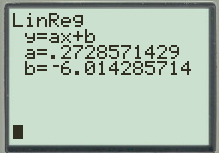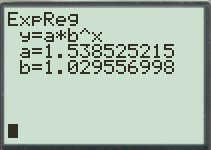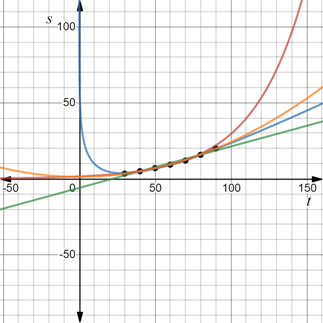
Concept explainers
a.
To calculate: The linear model
a.
Answer to Problem 60E
The linear model
Explanation of Solution
Given information:
The time measured in seconds required by a car to attain a speed measured in miles from a starting point is provided below,
Also, the above data can be modeled as,
Calculation:
Consider the time measured in seconds required by a car to attain a speed measured in miles from a starting point is provided below,
Follow the steps provided below to estimate the linear model.
Step 1: Press
Step 2: Press
Step 3: Enter the column 1 of table provided above in
Step 4: Enter the column 2 of table provided above in
Step 5: Press
Step 6: Press
Step 7: Select the fourth option that is
Step 8: Press
Step 9: Press
The result obtained on screen is provided below.

Therefore, linear model is,
Follow the steps provided below to estimate the exponential model.
Step 1: Press
Step 2: Press
Step 3: Enter the column 1 of table provided above in
Step 4: Enter the column 2 of table provided above in
Step 5: Press
Step 6: Press
Step 7: Select the fourth option that is
Step 8: Press
Step 9: Press
The result obtained on screen is provided below.

Therefore, exponential model is,
b.
To graph: The model that represent the data.
b.
Explanation of Solution
Given information:
The time measured in seconds required by a car to attain a speed measured in miles from a starting point is provided below,
Also, the above data can be modeled as,
Graph:
Consider the time measured in seconds required by a car to attain a speed measured in miles from a starting point is provided below,
Also, the above data can be modeled as,
The linear model
Plot the data points and all the models in the coordinate plane.

The green curve line represents
Interpretation:
All the models and the data points itself coincide with each other. All the models fits with the data.
c.
To calculate: The tabular estimation of the models for the data.
c.
Answer to Problem 60E
The estimation is provided below,
Explanation of Solution
Given information:
The time measured in seconds required by a car to attain a speed measured in miles from a starting point is provided below,
Also, the above data can be modeled as,
Calculation:
Consider the time measured in seconds required by a car to attain a speed measured in miles from a starting point is provided below,
The linear model
For each value of s compute the value of t for different models.
d.
To calculate: The sum of absolute values of differences between data and estimated values provided by each model. Also explain the model that best fits the data based on sums.
d.
Answer to Problem 60E
The sum is
Explanation of Solution
Given information:
The time measured in seconds required by a car to attain a speed measured in miles from a starting point is provided below,
Also, the above data can be modeled as,
Calculation:
Consider the time measured in seconds required by a car to attain a speed measured in miles from a starting point is provided below,
Also, the above data can be modeled as,
The linear model
For each value of s compute the value of t for different models.
Now, sum of absolute values of differences between data and estimated values provided by each model is,
For
For
For
For
The model that best fits the data is the one which has least sum of the absolute values of the differences between the estimated and actual data. This is represented by model
Thus, the sum is
Chapter 3 Solutions
Precalculus with Limits
- A Content X MindTap - Cengage Learning x Function Evaluations x + /ui/evo/index.html?elSBN=9780357038406&id=339416021&snapshotld=877369& GE MINDTAP , Limits, and the Derivative ⭑ វា a ANSWEI 16. Refer to the graph of the function f in the following figure. कर्ट AA C 54 -3-2 7 7 Ay 6. S 5. y=f(x) 4 3. 2. 1 -3- 34567 8 00 9 10 a. Find the value of ƒ (7). b. Find the values of x corresponding to the point(s) on the graph of ƒ located at a height of 5 units from the x-axis. c. Find the point on the x-axis at which the graph of ƒ crosses it. What is the value of f (x) at this point? d. Find the domain and range of f. MacBook Pro G Search or type URL + > % Λ & 5 6 7 29 ( 8 9 0arrow_forwardMorgan F. - C X A Courses MindTap - Cengage Learning Х Domain of Square Roots X + gage.com/static/nb/ui/evo/index.html?elSBN 9780357038406&id=339416021&snapshotld=877369& CENGAGE MINDTAP 2: Functions, Limits, and the Derivative 47. x if x < 0 f(x) = 2x+1 if x 0 Answerarrow_forwardA Content MindTap - Cengage Learning × Function Evaluations * + c/nb/ui/evo/index.html?elSBN 9780357038406&id=339416021&snapshotld=877369& GAGE MINDTAP ions, Limits, and the Derivative 15. Refer to the graph of the function f in the following figure. 6 y = f(x) 5 4+ 3- 2- 1 + 2 -1 3 4 5 6 a. Find the value of ƒ (0). Answer-> b. Find the value of x for which (i) f (x) = 3 and (ii) f (x) = 0. Answer ▾ c. Find the domain of f. Answer + d. Find the range of f. Answer+ MacBook Proarrow_forward
- Answer-> 12. Let g be the function defined by Find g(-2), g(0), g (2), and g (4). - +1 if x <2 g(x) = √√√x-2 if x 2arrow_forward13. Let f be the function defined by Find f (-1), f (0), ƒ (1) and ƒ (2). Answer f(x) = .2 J-x² +3 if x <1 2x²+1 2x²+1 if x ≥ 1arrow_forwardΛ Content Mind Tap - Cengage Learning × Function Evaluations x + c/nb/ui/evo/index.html?elSBN 9780357038406&id=339416021&snapshotld=877369& GAGE MINDTAP ons, Limits, and the Derivative 14. Let f be the function defined by Find f (0), f (1), and f (2). 2+1 x if x 1 if x 1 f(x) = 1 1-xarrow_forward
- A Content c/nb/ui/evo/index.html?elSBN 9780357038406&id=339416021&snapshotld=877369& GAGE MINDTAP ons, Limits, and the Derivative 11. Let f be the function defined by Find f (-2), f (0), and f (1). Answer f(x) = [ x² + 1 if x ≤ 0 if x > 0arrow_forwardGiven that 4−4i is a zero, factor the following polynomial function completely. Use the Conjugate Roots Theorem, if applicable. f(x)=x4−5x3−2x2+176x−320arrow_forwardeliminate the parameter to find the cartesian equation of the curve and sketch the graph. On the graph show the direction it takes and the initial and terminal point. Please draw by hand and show how you got to each steparrow_forward
 Calculus: Early TranscendentalsCalculusISBN:9781285741550Author:James StewartPublisher:Cengage Learning
Calculus: Early TranscendentalsCalculusISBN:9781285741550Author:James StewartPublisher:Cengage Learning Thomas' Calculus (14th Edition)CalculusISBN:9780134438986Author:Joel R. Hass, Christopher E. Heil, Maurice D. WeirPublisher:PEARSON
Thomas' Calculus (14th Edition)CalculusISBN:9780134438986Author:Joel R. Hass, Christopher E. Heil, Maurice D. WeirPublisher:PEARSON Calculus: Early Transcendentals (3rd Edition)CalculusISBN:9780134763644Author:William L. Briggs, Lyle Cochran, Bernard Gillett, Eric SchulzPublisher:PEARSON
Calculus: Early Transcendentals (3rd Edition)CalculusISBN:9780134763644Author:William L. Briggs, Lyle Cochran, Bernard Gillett, Eric SchulzPublisher:PEARSON Calculus: Early TranscendentalsCalculusISBN:9781319050740Author:Jon Rogawski, Colin Adams, Robert FranzosaPublisher:W. H. Freeman
Calculus: Early TranscendentalsCalculusISBN:9781319050740Author:Jon Rogawski, Colin Adams, Robert FranzosaPublisher:W. H. Freeman
 Calculus: Early Transcendental FunctionsCalculusISBN:9781337552516Author:Ron Larson, Bruce H. EdwardsPublisher:Cengage Learning
Calculus: Early Transcendental FunctionsCalculusISBN:9781337552516Author:Ron Larson, Bruce H. EdwardsPublisher:Cengage Learning





